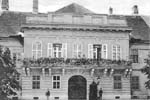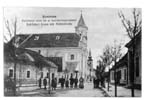|
Following the
architectural theories of the time, the
thickness of the fort walls ranged between
70 and 500 centimeters. In some places where
the walls are damaged, we can see the
ballast which forms the central part of the
walls. On the outer side this was girded
with one or two layers of brickwork. From
bastion I as far as bastion VII, the walls
overlooking the esplanade were built from
stone, and the walls facing the town were
built from brick. All the escarpments and
contrascarpments were built from stone. The
blocks of stone in both cases fit tightly to
each other, which indicates perfect
stonework. The foot of the brick façade was
always covered with stone and the corners
were strengthened with built-in stone cubes.

|
The perfect fitting of the bricks at the
vaults of the gates and windows helped
emphasise the pointings, increasing the
aesthetic effect of the building. Generally
the brickwalls were not covered with
whitewash made from lime, but in some cases
they were covered with a thin layer of
ochre-coloured whitewash. In those cases the
pointings were emphasised with a pale grey
colour. The front walls are closed with a
ledge built from red limestone. Complex
building methods were applied due to the
material requirements of the defence system.
Stone (limestone) and bricks were the
buiding materials of the walls. The crowning
cornices, the frames of the gates, windows
and doors as well as the footings and the
stone-plates indicating the serial numbers
of the bastions were all made from red
limestone. The architects pursued simplicity
and purpose, emphasizing the stability and
greatness of the building complex. The
loopholes on the facade, windows, doors as
well as the aerators are repeated regularly.
All the rooms are vaulted.

|
The ceilings are made from brick with such
accuracy, even though that was not required
by the purpose of the rooms. Mostly the
cradle vault was applied, which transmits
the weight of the ceiling (in our case the
heavy earthwork placed above the casemates)
to the vertical principal walls which close
the vaults. The cradle vault is mostly
segmental or round-arched. In the artillery
passages cradle-vaulted bays were formed
which served as gunpits. In bastion VI,
blind arcades to protect the artillerymen
from the hardship of weather were built in
two sidewalls of the central court. The
thickness of the vault is 65 cm. The layer
which forms the ceiling is covered with
quicklime mixed with rubble and then covered
with earth. The brick construction of the
interiors required perfect work. Connecting
the horizontal lines with the vaults was
done with great concern.
The dwellings were heated with stoves and their
walls were plastered. The floors of the
halls and corridors were made from burnt
brick, the earthen floors of the other rooms
were pounded down. Some parts of the places
outside – mostly where the cannons were
towed and where the soldiers assembled –
were paved. The characterisctic
architectural embellishments of each era can
be seen mainly on the gates:
-
Bratislava
Gate of bastion I – classicism
-
Gúta Gate of
bastion III - neorenaissance
-
Apály Gate
of bastion V - romanticism
Other artwork must be also mentioned, for
example the forged gates and grating. The
vaults of the gates, which close the
passages of the fortress and the central
courts, are mostly round-arched. Under the
vaults semicircular, stable, radial or
concentric lattice was placed. The wings of
the doors were made from juniper, and their
opening was facilitated by lead rails. The
ground-plate was paved. The gates of the
inner halls were not decorated, and they
closed with huge ironbars. The process of
the brackets that held the gates was not
complicated. All the openings of the inner
rooms which faced outwards (windows, doors,
loopholes, aerators) could be locked up. The
lintels of the rectangular windows are
segmental, their stone frames not
embellished. In some places the original
window-frames and glazing remained. All the
windows have simple iron lattice. In some
places above the loopholes we can see
semicircular openings which ensured the
ventilation of the rooms as well as some
feeble lightning. In the heavy artillery
casemates the openings above the loopholes
filled the function of the aerators.
Otherwise, apart from the above mentioned
facts, the ventilation was provided by the
central vents, which were built in the
ceilings of the passages.
The vaults of the cannon loopholes are
segmental; on the forefront it was
emphasized by voussoir. The cannon loopholes
were closed by heavy wrought-iron lattice,
which in some places can be seen even today.
There are two types of banquettes for small
firearms:
-
one is
directed towards the outside area: the
opening of the loophole in the thick
wall broadens both in the direction of
the inside and outside area with
bevelled shaping
-
one is
directed from one room to the other: the
narrow loophole is gradually broadened
again but only in the direction of the
defendants [so it broadens on the
fire-position side and it remains narrow
on the attacker’s side]
We can see right-angled holes on the inner
edges of the frames of the loopholes,
probably for the constructions that closed
the openings. The stone frames increased the
aesthetic effect of the building. All the
work done by bricklayers and other craftsmen
was carried out on a very high standard.
The fortification system also represents the
political and social conflicts which were
characteristic of that period and the
technical processes at that time. Two worlds
are encountered here, both the industrial
production and capitalism which had gained
more and more ground. The symbol of this is
the relationship between the railway and the
fortress. With the development of capitalist
production and trade, as well as improvement
of the firearms by the end of the 19th
century and especially by the beginning of
the first world war, the fortification
system became completely outdated.
|